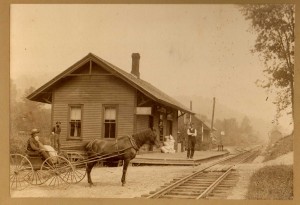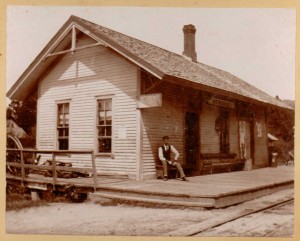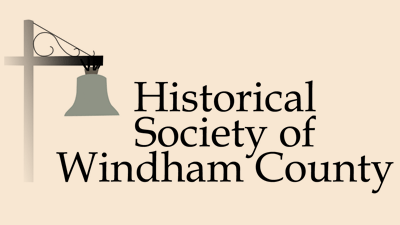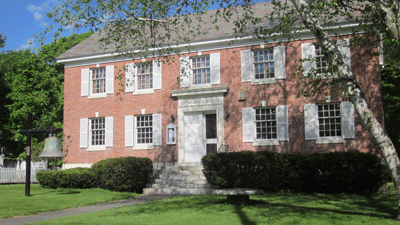Newfane Remembers Article on West River Railroad

The following article was published in 2003 for NEWFANE REMEMBERS, a volunteer project dedicated to collecting and preserving the recollections of residents about life in town in times past. This installment was written for the project by Castle Freeman, Jr., of Newfane, and is reprinted here with the author’s permission.
Sadly, all three residents quoted here, Merton Coleman, Stuart Halladay and Roy Brooks, have since passed away. It probably comes as no surprise that all three were active members of the Historical Society in their time. Members of the Coleman family have served the Society on its Board of Directors over decades, Stuart Halladay’s handsome mural of Newfane, a survey “from Rawson homestead to Higgins Store” dates from 1933 and hangs in the County Museum. Roy Brooks’s legacy to the Historical Society, the Roy Brooks Fund, continues to help finance the operation of the County Museum.
It is 67 years since a train of the West River Railroad went down the line from Londonderry to Brattleboro for the last time. Today the railroad’s most visible remains are the big stone bridge piers beside Route 30 near Dummerston Neighbors store and around the Newfane-Townshend line. Those towers, and a few of the old depots, are about all that’s left of the West River Valley’s 50-year experiment in railroading–an experiment that has, for the communities involved, taken on some of the character of myth. Fortunately for us, it’s a myth assisted by the memories of a number of local residents.

“The railroad put the Valley on the map,” remembers Merton Coleman of Williamsville. Merton recalls catching the train at Winhall station near Bondville and riding down to Brattleboro. In the 1920s, he also used to carry lumber from his family’s sawmill in Rawsonville and load it onto the railroad’s freight cars at Winhall for shipment to Massachusetts. Putting the Valley on the map was the railroad’s purpose, as it was conceived in the 1870s. It was built between 1878 and 1880, as a 36-mile narrow-gauge line that ran along the West River between Brattleboro and Londonderry. The line was, officially, the Brattleboro and Whitehall Railroad; its promoters hoped it would one day connect from Londonderry west to the New York Central in Whitehall, New York. (Convenient if you wanted to travel by train from, say, Williamsville to, say, San Francisco.)
The railroad carried freight and passengers up and down its route, running as many as six trains a day. The passenger train made the Brattleboro-Londonderry run in a little over two hours. That, at least, was what the published schedule said. In fact, the West River Railroad, from its outset, was famous for delay, derailment, and disaster.
Stuart Halladay of Newfane remembers riding down from Newfane one day when the train, approaching Brattleboro, “kind of dropped, bumped, and stopped right there. The tracks had spread apart or opened up somehow, and the wheels of the train just dropped down between them. So we were stuck. We had to walk on into Brattleboro.” (Stuart probably shouldn’t have been on the train in the first place, as his parents, fearing for his safety, forbade him to ride the West River line under any circumstances.)
Trains falling between their tracks weren’t rare on the WRRR. Stuart remembers, “My father told us that when the rails were laid down, the company would do the work on Sundays so the people along the line could help. They’d just give the rails to whoever happened to be around, and they’d lay them and spike them down. I don’t believe that, though.”
Whatever you believe, a lot of the West River Railroad’s problems undoubtedly came from its being built and kept up on the cheap. Roy I. Brooks, of Newfane, worked on the line in 1930, repairing the damage to the railroad done by the disastrous Vermont floods of 1927. He recalls the work: “Replacing ties, from the Salmon Hole bridge on the way up to Townshend, all the way to Brattleboro. We only replaced about every third tie, and they were replaced by softwood ties that hadn’t been treated. They should have replaced all the ties with treated ties—something that would last—but they didn’t have the money. There wasn’t much holding the rails.”

In a manner of speaking, Newfane was the climax of the WRRR’s run. The grade between Williamsville station, where the Rock River flows into the West, and Newfane depot, behind the present-day Newfane Market, was the steepest on the entire line. Railroaders called it “the ruling grade.” Roy Brooks remembers riding up to Newfane from Brattleboro one night in January 1934. “We started up the valley, and we got to Williamsville Station, no problem at all. But it was snowing. They got about halfway up from Williamsville, and the train couldn’t do it. And they backed up. Push ahead, push ahead, back up. And finally, four hours after leaving Brattleboro, we were at the crossing just below Newfane village. We got off and walked home. The problem was, they had only one engine, and the snow plow was in Londonderry. So the train had to keep pushing the snow. The people from Londonderry, I don’t think they got home til about noon the next day.”
The West River Railroad went out of business in 1936. It never did connect up to Whitehall; you never could go by train from Williamsville to San Francisco. The line’s rails and bridges eventually furnished scrap metal for World War Two. But the WRRR also furnished its valley with many good stories and with many memories, good ones–and the other kind.
Click here to return to the West River Railroad collection page.

